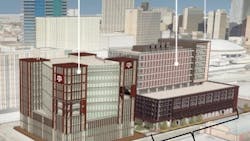Texas A&M gets green light for 2nd building for downtown Fort Worth campus
Aug. 2, 2024
2 min read
Texas A&M University's Board of Regents has given the go-ahead to begin designing what will be the second new building on its Fort Worth campus, dubbed Research and Innovation Building A.
The Fort Worth Star-Telegram reports that Building A is slated to house a number of Texas A&M system agencies. Texas A&M’s transportation institute, engineering experiment station, engineering extension service, AgriLife Research agency and the Texas Division of Emergency Management are all expected to be part of the research campus.
Texas A&M began construction last year on an eight-story, $185 million Law and Education Building, which is set to be completed in December 2025.
Research and Innovation Building A will be adjacent to it, across from the Convention Center. A second research-focused building is also a possibility.
Building A could cost as much as $260 million, according to Texas A&M. It will be financed by tenant leases, donations and parking revenue. Its 150,000 square feet of lab space and offices for Texas A&M agencies will cost $150 million. The rest of the property will have space for private-sector partners and parking.
It is unclear when construction of Building A could begin.
At the groundbreaking for campus’ first building in June 2023, it was announced that aerospace and defense manufacturer Lockheed Martin, aviation and defense company Elbit Systems of America, and eye care giant Alcon had made corporate partnerships with the Fort Worth campus. Companies will help design curriculum and lab spaces for research and innovation programs.
The 3.5-acre campus is expected to breathe life into underdeveloped land in the heart of downtown. It is expected to add jobs, increase property values, boost local workforce training and attract businesses, potentially lowering the residential tax burden.
About the Author
Mike Kennedy
Senior Editor
Mike Kennedy has been writing about education for American School & University since 1999. He also has reported on schools and other topics for The Chicago Tribune, The Kansas City Star, The Kansas City Times and City News Bureau of Chicago. He is a graduate of Michigan State University.
Sign up for our eNewsletters
Get the latest news and updates
